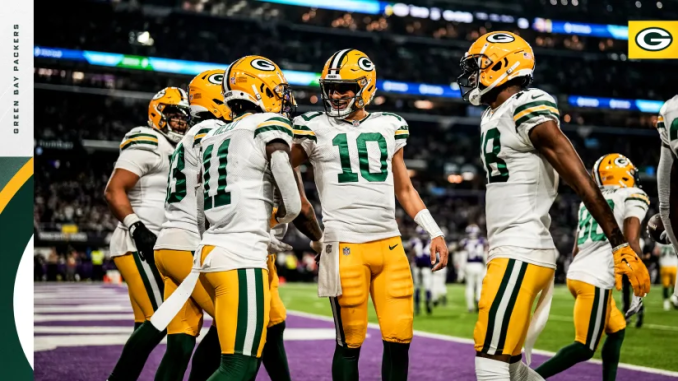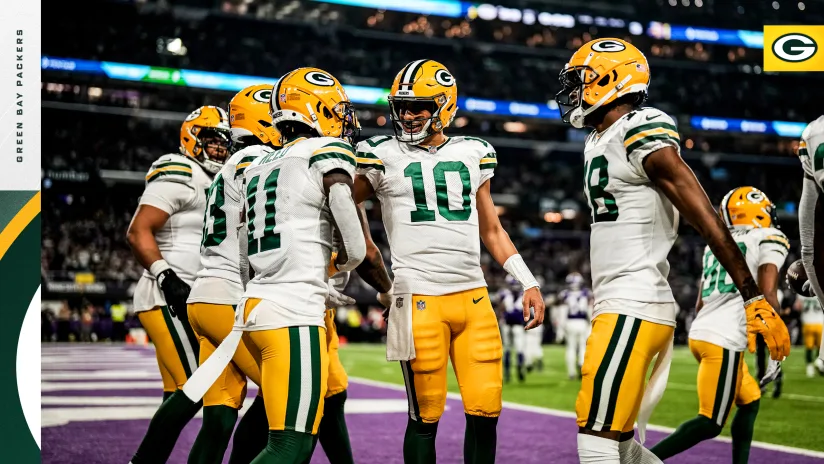
The Packers were mocked when they selected “quarterback of the future” Jordan Love with the 26th overall choice in the first round of the 2020 NFL Draft, despite the fact that Aaron Rodgers was still an MVP-caliber quarterback. Although the audacious decision irritated Rodgers and resulted in his ultimate departure from Green Bay, the Packers should have no regrets now.

Love spent three seasons on the bench behind Rodgers, who won two more NFL MVP titles in 2020 and 2021. The old-school approach to make Love wait paid off, as he had an immediate breakout season after replacing Rodgers as the full-time starter in ’23.
The Packers, under GM Brian Gutekunst, followed the winning plan laid down by his late predecessor Ted Thompson, who drafted Rodgers as a late first-round pick behind Brett Favre in 2005. Coach Matt LaFleur remained patient until the team had an opportunity to move Rodgers, and Love was prepared and ready to execute the offense when it came.
Here’s a recap of how the Packers shockingly and wisely picked Love, the newest addition to the strong 2020 quarterback class:
Jordan Love’s 2020 Draft Value
Love (6-4, 219 pounds) was one of the class’s most divisive prospects at any position, hailing from Group of Five school Utah State. He shone during the NFL Combine’s throwing and testing drills, solidifying his status as one of the top five quarterbacks off the board.
The question then became whether he could advance as far as the first round. Joe Burrow (No. 1 overall, Bengals), Tua Tagovailoa (No. 5 overall, Dolphins), and Justin Herbert (No. 6 overall, Chargers) all performed as predicted. Love was right up there with Jalen Hurts (No. 53 overall, Eagles) as the next most fascinating option, but more developing than the trio selected first.
The Colts (No. 34) and Patriots (No. 37) appeared to be strong second-round fits for Hurts or Love. After Burrow, Tagovailoa, and Herbert were selected early, and no team from No. 7 to No. 32 had a clear need at quarterback, it didn’t look promising for a fourth first-round pick. Green Bay suspected that some team would be aggressive to obtain Love’s upside late, so it moved up four spots from No. 30 to No. 26 in a trade with Miami.
The Packers saw Love as the best available player after the top 25 picks and tabled what they perceived to be more significant offensive needs.

They continued that approach by selecting running back AJ Dillon in the second round, despite possessing elite feature back Aaron Jones and steady No. 2 Jamaal Williams.
Packers’ 2020 Draft Needs
Between picking Rodgers 24th overall in 2005 and Love 26th overall in 2020, the Packers went 14 years without selecting an offensive skill player in the first round. Along the way, they helped Rodgers a lot by drafting Jordy Nelson, Randall Cobb, Eddie Lacy, Davante Adams, Jones, and Williams later in the draft. They also acquired two vital offensive tackles, Bryan Bulaga and David Bakhtiari.
Some of those players had left, and the rest were getting older, so GM Brian Gutekunst was right to wonder if they needed to refill the roster around Rodgers. The Packers, meanwhile, lost regarded wide receiver prospect Brandon Aiyuk to the 49ers one round earlier. They were red flags for offensive tackle Isaiah Wilson, who ended up being a huge disappointment for the Titans at No. 29 overall. They also received the ideal complementing back in Dillon late in the second round.
In retrospect, the Packers could have taken Tee Higgins (Bengals) or Michael Pittman Jr. (Colts) at wide receiver or Cole Kmet (Bears) at tight end. D’Andre Swift (Lions) and Jonathan Taylor (Colts) were also passed over as running backs behind Jones. These players all finished between 33 and 43 in the overall rankings.
The Packers did not draft a wide receiver in any round, showing that they were not impressed with the class after the first round. They had also just picked three in 2018. They did it again for Rodgers in 2022, and then for Love in 23. Love was considered as a luxury project pick, but in retrospect, he made the most sense compared to pressuring other positions too early.
Why did the Packers choose Jordan Love behind Aaron Rodgers?
Rodgers’ 2019 season, at age 36, did not suggest that he had two more great MVP seasons in him. He relied heavily on Jones’ running success under new coach Matt LaFleur during the transition from Mike McCarthy. There were also some early concerns regarding Rodgers’ compatibility with LaFleur.
In retrospect, the Packers had plenty of reasons to consider selecting Rodgers’ successor at some point during the draft. If Love had not been selected in the first round, as the Eagles did with Jalen Hurts in the second round, the emotional reaction to picking a “project QB” would not have been as strong.
The unexpected effect of the stunning pick is that it will drive and revitalize Rodgers for further outstanding performances in 2020 and 2021. Since his draft slide in 2005, Rodgers has thrived with a chip on his shoulder, so the Packers pressed the proper button in that regard. Then, when the 39-year-old Rodgers was not feeling it after another uncharacteristically weak season in ’22, Love’s presence made it the perfect time to part ways.
Jordan Love’s Promotion and Aaron Rodgers’ Trade
Last offseason, Rodgers and two draft picks were traded to the Jets for four draft picks.
When considering the deal, the Packers received two additional second-round picks, No. 42 overall in 2023 (tight end Luke Musgrave) and No. 41 overall in ’24.
The Packers gained draft capital and were willing to accept $40 million in dead money on Rodgers in exchange for $12.4 million in salary-cap relief. That was how certain they were that Love would thrive in LaFleur’s system and do better overall than Rodgers did in 2022.
They also recognized Love’s potential last offseason, when they drafted wide receivers Christian Watson and Romeo Doubs. In 2023, they added wide receivers Jayden Reed and Dontayvion Wicks, as well as two tight ends in Mugrave and Tucker Kraft.

As a result, Love had record rookie and second-year receiving performance in the Super Bowl era.
Meanwhile, Rodgers was attempting to make things work with two of his former Packers wide receivers, Cobb and Allen Lazard, playing important roles with the Jets. After Rodgers suffered a ruptured Achilles against the Bills in Week 1, those targets vanished out of the Jets’ limited passing attack.
While Rodgers planned his departure, the Packers devised a better entrance strategy for Love. Gutekunst’s decision to surround a young Love with support that an older Rodgers lacked is also telling, as there was a sense of freedom for the Packers to boost their quarterback rather of relying on him to do so.
Green Bay is in the division playoffs with a healthy Love in 2024. Without a healthy Rodgers, New York failed to make the playoffs. The Packers did not want to be like the Patriots, who had been looking for a quarterback for years. The fact that they had the foresight to jump on Love should be celebrated and praised for years to come.

Leave a Reply